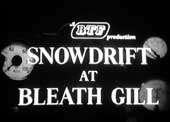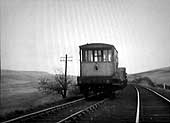Return to Main Index
The late David Watkin - Oscar-winning Cinematographer - reminisced about his time filming Snowdrift at Bleath Gill. www.davidwatkin.co.uk
"David Watkin was an unacknowledged assistant on this film. The film is 10minutes, largely devoted to the single task of freeing a goods engine and carriages from snowdrifts using a mechanised snow plough and gangs of diggers, mainly by the light of the Moon and huge Tilly lamps.
“Ken Fairbairn was a nice man. Known as “Twitcher” because of a tendency to be hyper-anxious whenever you were sorting out the necessary things for the shot to be useable. He was also small in stature, resulting in most of his set-ups being done on the baby-legs, which was a bit trying. He wrote his own scripts for the most part; one that I did for him about the lost luggage office was called A DESPERATE CASE. Another about incoherent station announcements had a similarly apt title to begin with: GET LOST! But Edgar made him change it. A phone call about about 9.30 one freezing evening asked would I collect some camera gear with Bob Payntor and travel up to Barnard Castle in Yorkshire. There we bundled ourselves inside a snow-plough and set off to rescue a train stuck in a snowdrift at a place near Stainmore Summit called Bleath Gill. The snow-plough was a massive steel prow-like structure stuck on the front of an ordinary guard’s van propelled by a couple of engines. It was cosy enough inside with a nice stove and a mad-looking guard – cosy that is until it began to fill with smoke and the mad-looking guard threw in a couple of detonators “to clear the flue”. Reaching a quick decision between being frozen or blown up I hung as far out of the window as possible, and after a massive explosion the stove, thus brought into line, glowed splendidly for the rest of the journey.
The first revelation about snow-ploughs is that it is unsubtle to charge bull-headed at a drift since the plough would then get itself equally stuck after about ten yards. Instead a gang of men with shovels dig three foot wide trenches at similar intervals across the track so that when the plough finally gets a run at it there is quite a good shot of snow flying in all directions. The lighting for the gangers, and now us, was a collection of the largest Tilly lamps ever seen (with reflectors the size of a 2K) and it fell to me to set these at intervals beside the line and then traipse back and forth keeping them pumped up (just like Frank Brice on NIGHT MAIL except instead of running about a field I was wading though snow up to my ears). It took the rest of the night and the whole of the following day to finally dig the thing out – an uncongenial task, and not only to us. At a subsequent showing of the film in the area, one of the railway officials involved commented that “If it hadn’t been for the fucking film people we’d have just left her to thaw out.”
Icy blast that caused mayhem on roads and on the railways
by Chris Lloyd, Northern Echo
The winter of 50 years ago was one of the coldest of the 20th Century. People of a certain age still talk about 1955 - it was so cold with "25 degrees or more of frost" that The Northern Echo reported that patches of the North Sea off Teesmouth had frozen.
The Wear was solid from bank to bank at Durham; the Tees was equally ice-bound from Stockton right back to High Force.
The January had been cold, but the February became a deep freeze. There was 10ft of snow covering much of Teesdale - and that was before the night of February 23 when "Arctic conditions. . . the worst in living memory" set in on Stainmore. Drifts were 30ft deep in places.
The Echo reported that 100 vehicles were stranded on the Pennine summit of the A66, including a GNE Motor Services bus, driven by Mr D Coombs of Darlington, with ten passengers on board. They were travelling east from Carlisle, but got trapped at about 6pm - along with the snowplough that was trying to get them out. Among those who slept on the bus that night was a 19-year-old mother from Dumfrieshire and her three-month-old baby. Nearly 24 hours later, a North Yorkshire snowplough managed to reach them.
"As the snowplough came within sight of the stranded colony there were no cheers of welcome, only anxious faces peering expectantly through the blinding snow in the hope that this would bring relief, " said the Echo whose reporter and photographer had walked four miles across the snow plain to cover the story. But, by then, the real story was not on the road. It was on the nearby rail.
And it is a story that was captured on film: Snowdrift at Bleath Gill. The railways were nationalised in 1948. In 1949, they decided they needed their own film department - British Transport Films (BTF) - to produce both staff training films and public promotional footage.
This was the age of the cinema's great silver screen and BTF's ten-minute documentaries were B-movies to be shown just before the main attraction.
Snowdrift at Bleath Gill is one of BTF's most famous minimovies, beautifully shot in evocative black-and-white (by director Robert Paynter, who later worked with Michael Winner and co-directed An American Werewolf in London).
It has stirring 1940s industrial music and a commentary by Deryck Guyler who later found comic fame as the caretaker in Please Sir! and Corky the police constable in Sykes.
BTF was probably able to make the film because the 4.20am goods train out of Kirkby Stephen was stuck for so long.
Engine No 78018 - Standard class, built in Darlington just the year before - set out on the morning of Thursday, February 24, hauling eight 20-ton wagons packed with limestone and minerals. At 5am, she became stuck in Bleath Gill. And there, with her crew, she remained, marooned near the Stainmore summit 1,370ft above sea level until 3pm the following Monday, when the first rescue teams arrived. These were men from Darlington, West Auckland and Barnard Castle - getting on for 50 of them, judging by the film - and their first job was to dig deep trenches through the rock-solid snow.
"It's a bit like eating landlady's cake, " says Deryck Guyler's commentary. "The more it is divided, the easier it is to get through."
The men stayed out all night, digging away in winds of 40mph - fortunately, in those days, no one had invented the term "windchill factor". Reinforcements were sent out the following morning. One of them was Jackie Leng, now 83 and chairman of the Friends of Darlington Railway Museum. "We left the sheds at Bank Top with a couple of brake vans filled with paraffin, old rags and cotton waste - anything to build a fire around the cylinders, " he recalls. "It was a cloudless sky - you would have thought you were in Switzerland."
The BTF film - in which you can just make out Jackie in a trenchcoat - shows the snowplough running full steam ahead around a curve into a drift and destroying it in a magnificent cloud of flying snow, hissing steam and pluming smoke. It must have been an exhilarating sight on a wide cinema screen.
But reaching a stricken engine was the easy part of an operation. Because when a steam train gets stuck, the heat from its boiler melts the snow around it. As the boiler cools down, the frost nips back in, freezing the melted snow so that eventually the engine is entombed in a block of ice. "It was just a case of thawing it out, " says Jackie, who was a fitter at Bank Top from 1948 to 1970. "You draped rags around the motion and set fire to them, and then you got the steam lance - a long hose with a nozzle - which was attached to the boiler of the engine which had brought us up and used that for melting the ice inside it." The fires around the engine's moving bits burned for two or more hours, but did the trick.
After five days stuck in the snow, No 78018 was freed. She was hauled down to West Auckland (by fellow Standard classes No 78015 and 78017), and the line over the Pennines was reopened. Her rescue appears not even to have merited a paragraph in The Northern Echo of the time. In those days it was routine for steam trains to take on the elements in the most exposed of locations and so, in their bravery, it was only natural for them to occasionally become stuck. But the presence of the BTF film crew ensured that this rescue has remained famous these past 50 years. Snowdrift at Bleath Gill was shown a year or so ago on Channel 4 and is still easily available on a video compilation of BTF's greatest hits, for about £15.99.
If you have any information about anything mentioned in today's column - particularily if you were part of Snowdrift at Bleath Gill - please write to Echo Memories, The Northern Echo, Priestgate, Darlington, DL1 1NF or email chris.lloyd@nne.co.uk or call 01325 505062
















 Actual screen shots reproduced by kind permission
Actual screen shots reproduced by kind permission